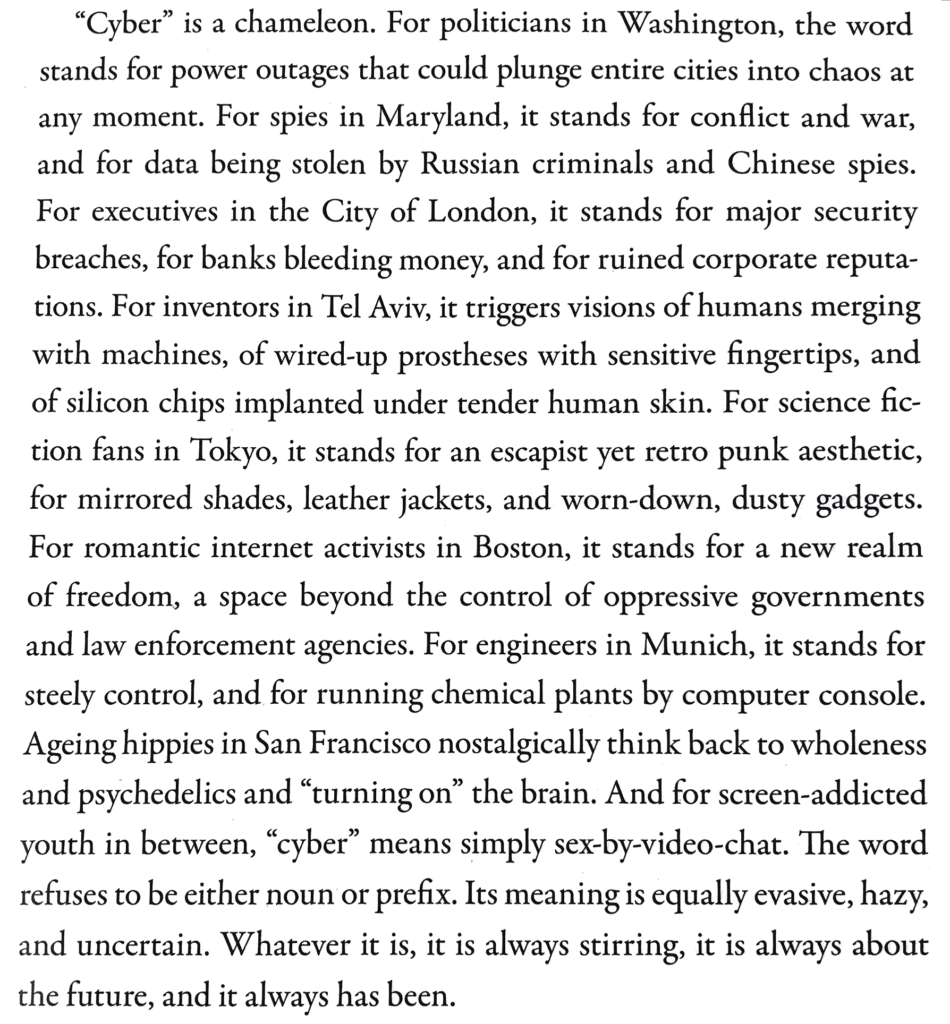After spending the semester exploring the building blocks of cyber-physical systems (context, taking things apart, data, Machine Learning and Algorithms, and Systems Mapping), the final fortnight of the 3AI Master of Applied Cybernetics Questions Course was focused on putting these elements together and understanding a bit more about the history and influence of the field of cybernetics.
The word cybernetics comes from the Greek verb kybernan which means ‘to steer, navigate or govern’. According to Thomas Rid (2016, pp xi), the meaning of cyber is a chameleon:

The Macy conferences (Summary: The Macy Conferences, 1949) are an important part of the cybernetics story. They were a series of meetings across 1941-1960 with an explicit aim of communicating across disciplines, with attendees spanning neurophysiology (McCulloch, Pitts, Gerard), physics (Wiener), psychology (Koeler, Lashley), psychiatry (Kubie), anthropology (Mead, Bateson), polymaths (von Neumann, Simon) and many others.
These conferences can be seen as exercises in convening lines of difference across disciplines. When looking at the history of the Macy conferences through a lens of group dynamics, a few things emerge. Firstly, an undercurrent that the ‘hard sciences’ were perceived to be of more value than ‘social sciences’. This is evidenced in Wiener (1961)’s book – Cybernetics: or control and communication in the animal and the machine – where he dedicates a paragraph to disagreeing with Bateson and Mead that the social system side of cybernetics should be a focus for him. Similarly Northrop, the sole philosopher of the core Macy conference attendees is said to have discerned a lack of interest in the group regarding the philosophical issues he was raising and he rarely spoke out after the first of the Macy conferences (Summary: The Macy Conferences, 1949). Also, commentary on the Macy conferences (Summary: The Macy Conferences, 1949) indicates that “it remained the case throughout the conference series that the neural mechanisms people…were repeatedly critical of what they perceived as fuzzy or vapid theorization (particularly with regard to the psychoanalysts).”. What do such dynamics mean for the evolution of cybernetics?
Secondly, it must be noted that particular disciplines were not represented at the Macy conferences. In particular, political sciences and economics never participated (Summary: The Macy Conferences, 1949). What does this reveal about the voices heard and considered? All of these instances are clues about the power dynamics at play in this interdisciplinary group. As aspiring practitioners of the New Branch of Engineering (NBE), it strikes me that it’s not enough to have all of the voices at the table (and even that is difficult to achieve), consideration as to how they are able to meaningfully contribute is also necessary. This requires an ability to identify and manage power dynamics and create environments that value all voices in the room. How might we practise, develop and execute these skills?
Thirdly, the convenor of the Macy conferences was Freemont-Smith of the Macy Foundation. What can we learn from Freemont-Smith in trying to understand how to convene lines of difference? It is of note that this was a philanthropically funded set of conferences. What role does philanthropy need to play in multi-disciplinary convenings? How does the funding source influence what can be discussed and how?
Finally, cybernetics was, for the Macy conference attendees, what Star (2010) would call ‘a boundary object’. That is, a concept that could be interpreted in different ways by different people, allowing diverse groups to work together without consensus and around which a community of practice based on shared practice and language for collaboration can emerge (Star, 2010). Cybernetics became a ‘shared space’ for otherwise disparate disciplines to converge and work together. In the case of the Macy conferences, the word cybernetics emerged as fitting for the group to move forward under a common umbrella (Summary: The Macy Conferences, 1949). It is also possible, however, that boundary objects are intentionally created as a mechanism for collaboration. An example of this in practice can be seen in Rodriguez (2017)’s recount of a boundary object made to promote research engagement with policy makers.
The Macy conferences provide an interesting window into cybernetics as a field. This history and context is carried in to the New Branch of Engineering that is being defined at the 3A Institute.
One thing that strikes me from understanding more about the Macy conferences is that these conferences served as a fascinating experiment in convening lines of difference. As we consider the design, implementation and decommissioning of cyber-physical systems of the future, I am left with many questions such as:
- How do we, as aspiring practitioners of the NBE, convene lines of difference in such a way that constructive collaborative processes can unfold?
- How do we learn about how to become good at building these types of environments?
- What does it take to be able to create useful boundary objects as a mechanism for progressing a shared agenda forward with disparate stakeholders?
- How do we best manage power dynamics to ensure an equitable playing field of voices at the decision-making table?
We will continue to explore these types of questions throughout the second semester where the focus shifts to applying questions to real-life cyber-physical system case studies.
For further insights into the 3AI Master of Applied Cybernetics course, take a look at the 3A Institute’s Medium article here.